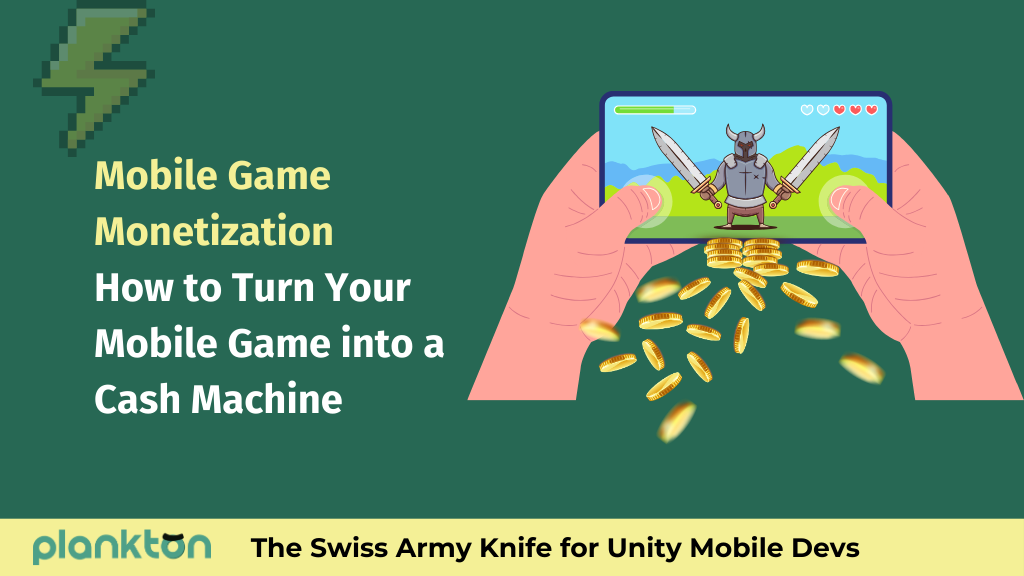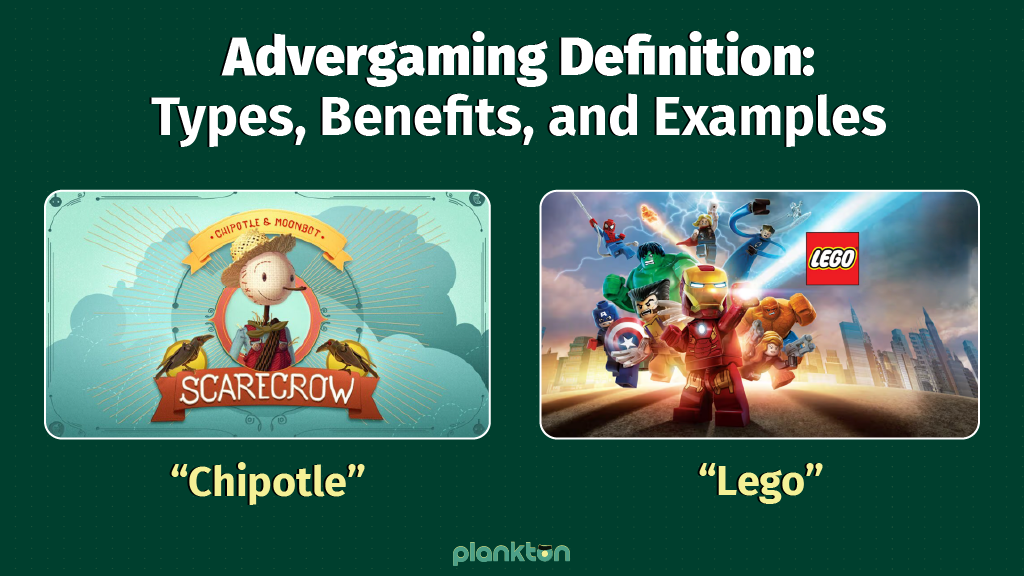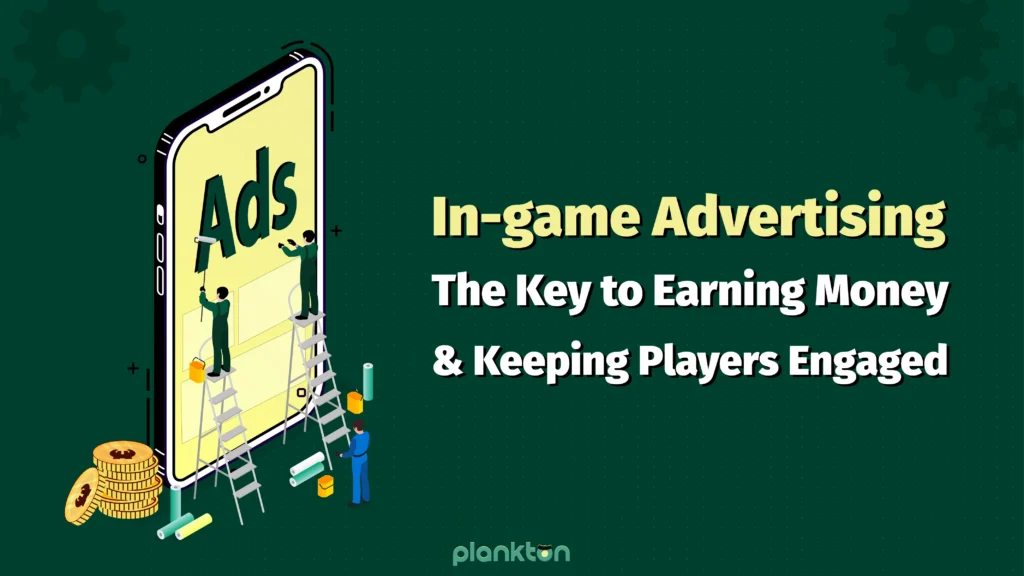In this comprehensive article, I’ll guide you through mobile game monetization. You had a fantastic game idea; you’ve put days and months of work into building it, and finally it’s ready to be listed in the app stores. But you have one question in mind: How to monetize your mobile game?
Creating a great mobile game is one thing, and being able to maintain users and make a profit is another. The key to surviving in the market is crafting the perfect mix—that is, balance. Your users should enjoy their experience, but you also need to make money.
So, you’ll find answers to these questions: What is mobile game monetization? What is the first step to monetize your game? What are common types of monetization (introducing the most popular model), and what is the best model for me, all with examples and details to help you understand the terms and concepts better.
Plus, at the end, you’ll get expert tips to avoid mistakes and boost your earnings—insights you won’t find anywhere else.
If you’re ready to build a revenue stream from your mobile game, keep reading until the end.
What Is Mobile Game Monetization?
Let’s make it simple: Mobile game monetization refers to strategies and methods developers (or marketers) use to make money out of their gaming app.
Creating a mobile game is not cheap. You have to put in lots of effort and resources to build a game that appeals to gamers. And you’re gonna gain money from it unless you’re a non-lucrative organization (or person) that doesn’t care if the game gets buried in the 100th page of app stores.
There are games that generate billions of dollars; at the same time, others are doomed from day one. Whether a mobile game succeeds or fails depends on many factors we don’t wanna talk here.
But I can say that if you think about monetizing from day one, you’ll significantly increase your chances of dominating the stores.
Why from day one?
Because it’s crucial to design the ad placements in the game with the optimal user experience in mind. Otherwise, you’ll finish the game struggling with how to fit monetization opportunities inside the game.
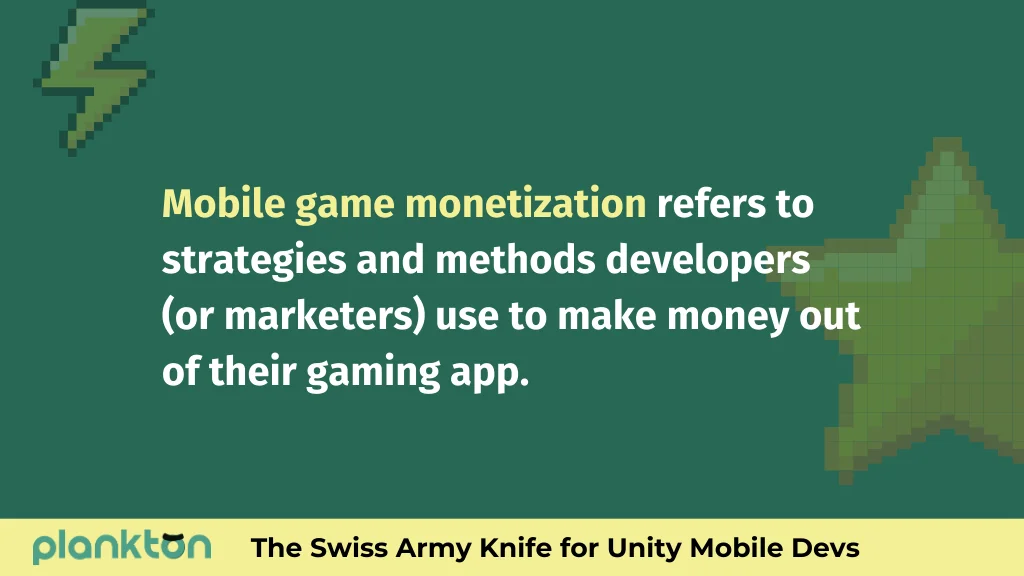
Another point is that monetizing gaming apps can be a double-edged sword. It means you have to make a perfect balance between user experience and making money. Otherwise, users uninstall your game, and you can’t survive in the ocean of mobile gaming competition.
But don’t panic. I’m here to help you craft a revenue plan to make the most of your monetization efforts. Our focus will be on ensuring that gamers can enjoy their time playing their favorite mobile game without any disruptions. This way you’ll escape from zero-star reviews on app stores.
The First Step to Monetize a Mobile Game
You have a brilliant idea with the best gameplay. You know it’s gonna work and gain tens of thousands of players. Sure, this is so important. But thinking about how to make it profitable is equally as important.
Game creators should consider revenue streams from the earliest stages, as it will affect the game design, gameplay, difficulty, and more. If you select your main income source from the beginning, you’ll have done most of the hard work: balancing between user experience and profit.
You should first know what monetizing strategy fits your genre, your target audience, your region, and other elements.
If you’re wondering how to do that, please refer to this section.
Now let’s see how developers and studios are making money from their games.
Common Mobile Game Monetization Strategies
There are various methods to monetize a mobile game. From in-app ads to subscription model, each one has its own features, no need to mention that each model fit a different game genre.
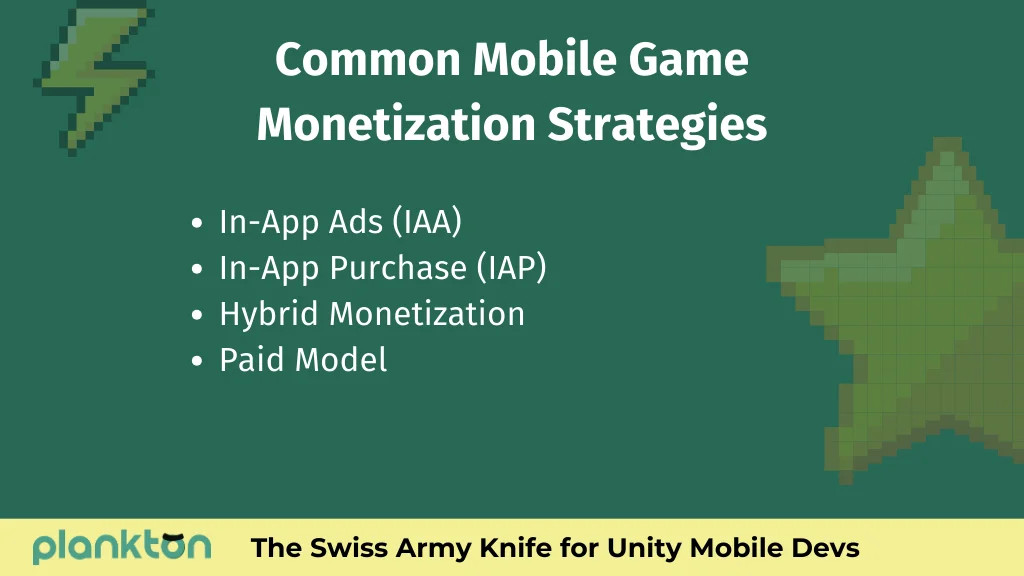
First let’s make a short trip to the past, then I’ll tell you about the models.
Our world is in constant change, and every day something new comes to the market. If you’re old enough to remember the first years, the gaming world was dominated by paid games. It was common to buy your favorite game once for a few dollars (sounds crazy, no?) and enjoy it until the end.
Then came Candy Crush, a popular mobile game known as freemium. It means you could download and play it for free. If you wanted to proceed faster (or gain special assets), you could pay a small amount inside the game. Voilà! The famous term in-app purchase (also called IAP) was born.
Let’s flash back to today; things are quite different.
May the Games be Free, and the Fun Never End
Nowadays, players expect to find their entertainment in the app stores for free. And games generate income from in-app purchases, in-app ads, or other methods (continue reading to learn about them).
However, the paid games are not dead yet. If you explore Google Play or the Apple Store, you can find games with a price label that are attracting players and bringing in cash.
There are around 450,000 mobile games in the Google Play and App Store. If you want to find your place among your competitors, it’s a beneficial idea to offer your game as a free-to-play (known as F2P) and then make money from available methods.
And here comes the challenge: you have to be careful not to go too far with monetization, as it will cost you a high price. It’s not hard to find a mobile game that shows you an ad every 10–20 seconds. Checking the review section, there are frustrated players complaining about “too many ads”.
Another trap is blocking the players’ progress. Going ahead in some games is almost impossible unless you open your wallet to the developer. They are often called pay-to-win games.
Can these games survive? Indeed, they can survive, but the income will not be stable.
Balance is the Key to Success
Overall, the perfect balance between offering the best experience and making the project profitable is not easy. But the good news is that it’s not impossible.
People understand that developers need to earn money from their games to survive. But they don’t like to be bombarded with ads and in-app purchase offers.
The same situation happened during the era of free cable TVs, which featured advertisers shooting ads at viewers every second (I know I’m exaggerating a bit). You couldn’t watch your favorite series without interruption, and sometimes it was a real headache. I’m happy we’ve gotten past that situation!
Enough with history; let’s dive into the common monetization models.
In-App Ads (IAA)
In-app ads are a great way to monetize your mobile game, helping you generate revenue without requiring players to make purchases. They can be shown at various points during gameplay, and there are a few key types you’ll commonly see in mobile games:
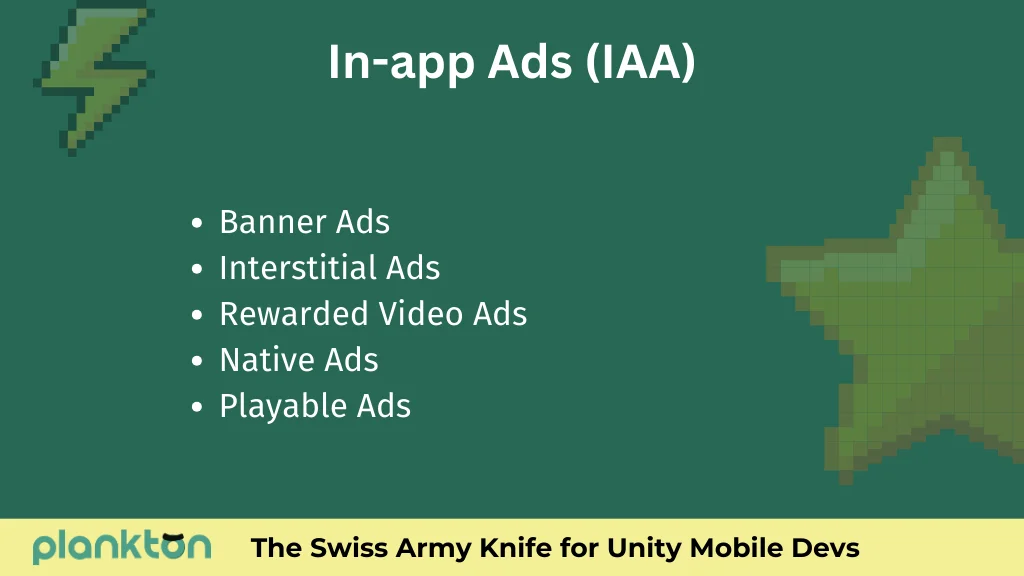
Banner Ads
These are small, rectangular ads that appear at the top or bottom of the screen while players are playing. They are always there. While they don’t interrupt gameplay, they can still bring in steady revenue through frequent impressions.
Interstitial Ads
These full-screen ads pop up between game levels or during natural breaks in gameplay. They grab the player’s attention and can be a beneficial way to boost earnings, but make sure to use them sparingly to avoid annoying players.
Rewarded Video Ads
It gives players the option to watch a short video in exchange for a reward, like in-game currency, extra lives, or other bonuses. Players appreciate this because they’re getting something valuable in return, and it leads to higher engagement.
I like to call it the “win-win ad”. You win by showing ads and earning money while not forcing it into players. At the same time, players have the option to watch them and gain a good reward.
Know a better win-win deal?
Native Ads
These are ads that blend seamlessly with your game’s content, making them feel like a natural part of the experience. For example, an ad might look like a game feature or item that players can interact with, keeping the user experience smooth.
If you play Subway Surfers, sometimes you can find brand names on the walls. It’s an example of a native ad.
Playable Ads
These ads let players try out a mini version of another game before deciding to download it. They’re interactive and often more engaging, which can lead to better conversion rates for advertisers and more interest from players.
Want to learn about the most common types of mobile game ads and how to use them to boost revenue? Read on!
In-App Purchase (IAP)
In-app purchases allow players to buy virtual goods or premium features within your game. This can range from cosmetic items to boosting progression, and it’s a great way to monetize your game while keeping the experience enjoyable for players.
There are two types of in-game assets:
Consumable Items
These are items that players buy and use up over time, like extra lives, in-game currency, or power-ups. Once used, they can be purchased again. Players often appreciate this option because it enhances their experience without permanently altering their gameplay.
Non-Consumable Items
These items are bought once and remain in the player’s account forever. Examples include unlocking a new level, special characters, or a character skin that generally doesn’t expire. Players love non-consumables because they provide lasting value without needing to buy them repeatedly.
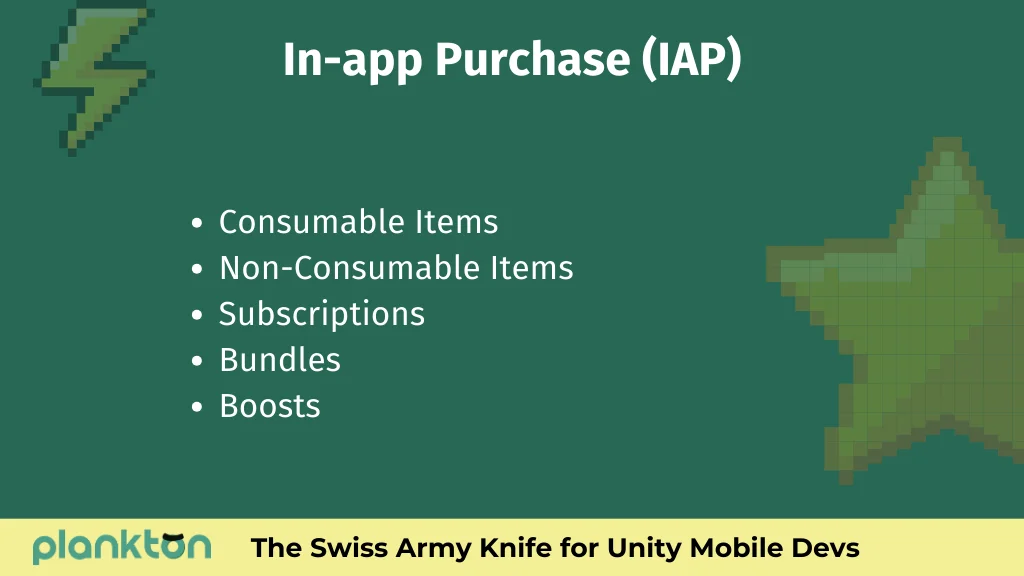
Additionally, you can implement other offer types to create more value for both your game and your players. These offers can be:
Bundles
Bundles offer a combination of in-game items, currency, or perks at a discounted price. They’re designed to give players more value than buying items individually, making them an appealing choice for players looking to save while getting a lot.
Why Bundles Work:
- Higher Perceived Value: Players feel they’re getting more for their money, which increases their willingness to spend.
- Encourages Larger Purchases: Bundles often combine popular items, enticing players to spend more in one go.
- Great for Special Events: Limited-time bundles tied to holidays, updates, or events create urgency and excitement.
Example: A starter pack with in-game currency, a powerful weapon, and a rare skin at a 50% discount is a great way to convert new players into paying users.
Boosts
Boosts are temporary upgrades that enhance gameplay by helping players progress faster or gain extra rewards. They are especially appealing to players who want to save time or overcome challenging levels.
Types of Boosts:
- XP Boosts: Increase the rate at which players gain experience points, helping them level up faster.
- Resource Boosts: Double the amount of in-game currency or resources players earn for a limited time.
- Power Boosts: Temporarily enhance player abilities, making tough challenges easier to conquer.
Why Boosts Work:
- Instant Gratification: Players see immediate benefits, which makes the purchase feel worthwhile.
- Appeals to Competitive Players: Players who want to stay ahead or catch up quickly are more likely to buy boosts.
- Time-Savers: Boosts reduce grind time, making them perfect for busy players.
Example: A 3-day XP boost that doubles experience points earned from battles encourages players to keep playing while maximizing their progress.
Subscription Model
Some consider subscriptions a separate monetization type, and for others, they fall under the IAP category. Anyway, it allows players to pay a recurring fee for ongoing benefits, such as exclusive content, bonuses, or an ad-free experience.
This model can generate steady income, and many games offer daily, weekly, or monthly subscription options, making it flexible for different players.
For example, in Clash of Clans, the Gold Pass is part of their seasonal challenges, offering players exclusive perks and rewards for a monthly subscription fee.
Hybrid Monetization: The Best of Both Worlds
Hybrid monetization combines in-app ads and in-app purchases (IAPs) to create a well-rounded revenue strategy. By offering multiple ways for players to spend, you can maximize earnings while keeping the game fun and accessible.
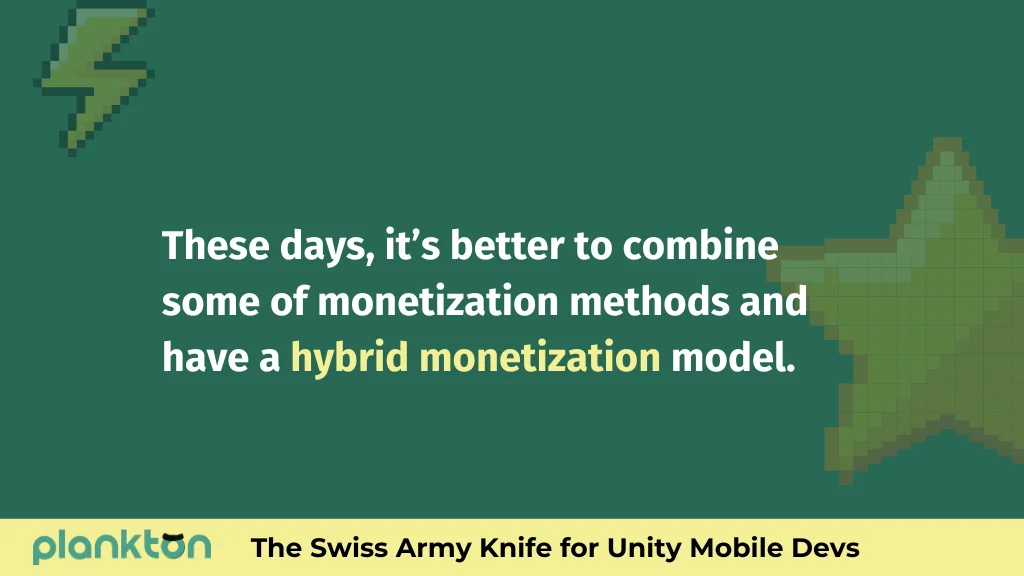
Let’s check the common hybrid models:
Model 1: In-App Ads + In-App Purchase (IAA +IAP)
This is the most common hybrid model, combining rewarded ads or interstitial ads with optional IAPs. Players can choose between earning rewards by watching ads or purchasing items outright.
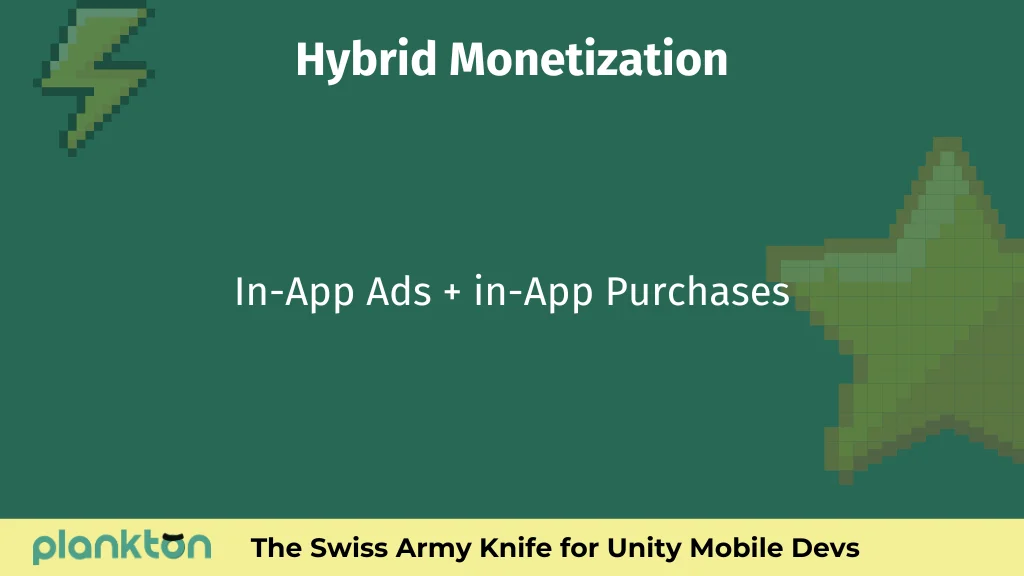
Why It Works:
- Flexibility for Players: Players who don’t want to spend money can still earn rewards by watching ads, while spenders can enjoy premium features.
- Maximized Earnings: Capture revenue from both ad impressions and player purchases.
Example: A player can watch a rewarded ad to get 50 coins or directly buy 500 coins for $4.99.
Model 2: Subscriptions + In-App Purchases
This model offers players ongoing perks through subscriptions while providing additional options to make one-time purchases. Subscriptions often include exclusive rewards, premium currency, or access to VIP features.
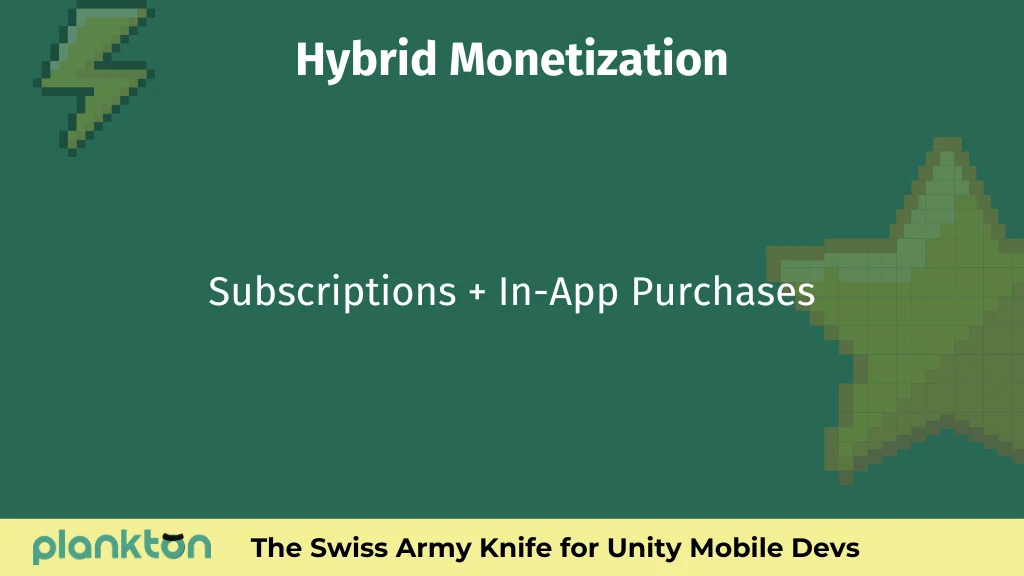
Why It Works:
- Recurring Revenue: Subscriptions provide steady, predictable income for developers.
- Loyalty Boost: Players who subscribe are more likely to stay engaged in the long term.
Example: A monthly VIP subscription gives players daily rewards, faster progression, and an ad-free experience while still allowing them to buy in-game items individually.
Model 3: In-app Ads + In-App Purchases + Subscriptions
This is the most comprehensive hybrid model, combining ads, IAPs, and subscriptions to cater to all player types. Free players can watch ads for rewards, paying players can make purchases, and dedicated fans can subscribe for premium benefits.
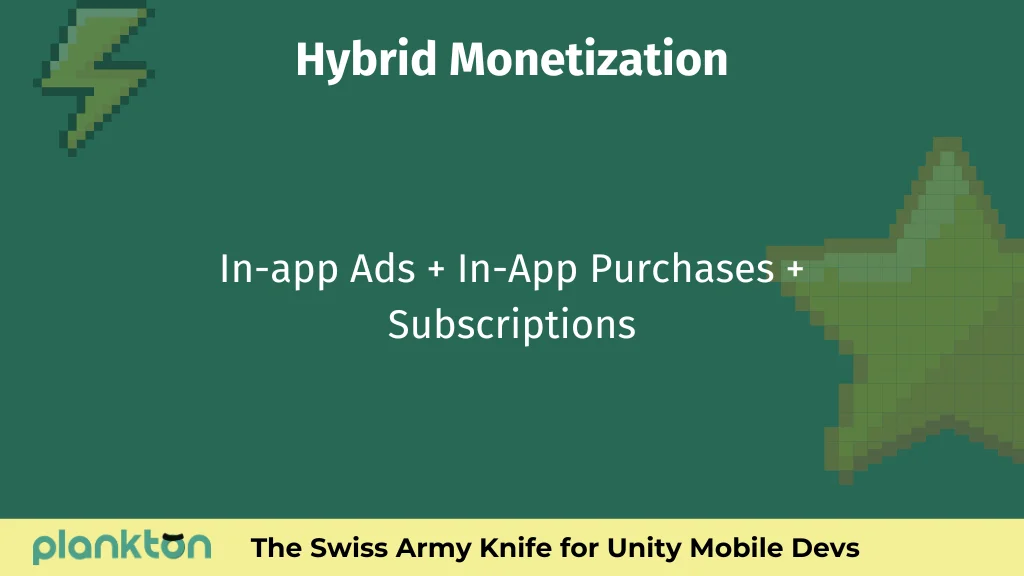
Why It Works:
- Reaches All Audiences: Monetize casual players through ads, moderate spenders with IAPs, and loyal players with subscriptions.
- Diversified Income: Balances ad revenue, one-time purchases, and recurring subscription fees.
- Customizable Experiences: Players choose how they engage, creating a sense of fairness.
Example: Free players see rewarded ads for extra rewards, can purchase skins or power-ups directly, or subscribe to a monthly VIP package for an ad-free experience and exclusive items.
Offer Flexibility with Multiple Monetization Streams
Hybrid monetization gives players the freedom to choose how they want to spend. Whether they want to watch ads for rewards or make purchases to enhance their experience, offering both options increases player satisfaction and overall revenue.
The key to successful hybrid monetization is balancing ads and purchases without overwhelming players. By integrating ads at the right moments and offering valuable purchases, you can create a monetization system that feels rewarding for players while boosting your income.
Paid Games: One-Time Purchase for Unlimited Fun
In the paid games model, players pay upfront to download and play the game. This is a straightforward approach, where the purchase gives players full access to the game without additional fees.
Paid games provide a premium experience from the outset. By charging a one-time fee, developers provide a complete game with no ads, no in-app purchases, and no distractions—just pure gameplay. High-quality, story-driven games or those that offer extensive content from the start benefit greatly from this model.
Why Choose the Paid Model?
- Predictable Revenue: You know exactly how much income you’re generating from each download.
- No In-Game Interruptions: Players appreciate not being interrupted by ads or constantly pressured to make purchases. It’s all about the experience.
- Appeals to Hardcore Gamers: Players who prefer to pay once and enjoy the game without additional costs often gravitate toward paid games.
Challenges of the Paid Model
While the paid games model offers simplicity, it can be harder to reach a wide audience since players have to commit to a purchase before even trying the game. Marketing and positive reviews become crucial to attracting new users.
The paid model works well for developers who want to offer a high-quality, uninterrupted experience. If your game is designed to deliver a rich, immersive experience right away, this monetization model could be the perfect fit!
What Is The Best Way to Monetize a Mobile Game
As you may have heard it a thousand times—yes, I want to repeat that again: “there is no one size fit all solution.” As mentioned earlier, there are several models at your disposal. These days, it’s better to combine some of them and have a hybrid monetization model.
Let me give you an example. If you’re offering a hyper-casual game, it’s not wise to make money from in-app purchases. Because people play this genre to kill some time and have fun. They’re not eager to make purchases to get along. Then, the best choice would be an in-app ads strategy.
On the other hand, in the action genres, where people get engaged with one or more characters and want to advance fast in the game or go on a killing spree, they’re not afraid to drop some bucks to boost their weapons or armor.
Another factor is that in countries where income per capita is low, you can’t expect a cash river. But in powerful economies, gamers pay easier. So, the rule of thumb says it’s better to use in-game ads for the first group and in-game purchase for the second.
Overall, each game and genre is unique and requires its own approach to monetizing.
Tips for Mobile Game Monetization from Experts
If I want to mention one crucial tip to help you rely on your mobile game revenue, that would be focusing on user acquisition (UA) from day one. The more users you get through marketing campaigns, the higher your chances of gaining organic users.
The ideal scenario is that you show less advertisement (better user experience) while you show more expensive ads. If you can gain a good number of gamers over two or three months, you are on the right track and can expect a good profit.
Here are extra tips to help you boost your earnings and get up in the app stores:
Make Players Happy
When you have gamers that love to play your game, you’ll have more of what is known as Daily Active Users or DAU (it’s the number of unique players who play your game on a single day, showing its daily engagement and appeal).
The more DAU you have, the more ads you can serve. Besides, if players spend more time within your game, it’s more probable they buy some items and make the cash register ring.
Go for High Retention Rates
If you get many players with high retention rates (more players come back to open your game), you ensure that you’ve cemented the foundation of your monetization efforts.
Be Friend with Ad Mediations
Let me give you an example. AdMob, a popular ad mediation from Google, gives something like a credit for each ad place. The concept is something like SEO or ASO. The more you can satisfy gamers and generate revenue, the more AdMob is willing to display your ads to users, and the cycle continues.
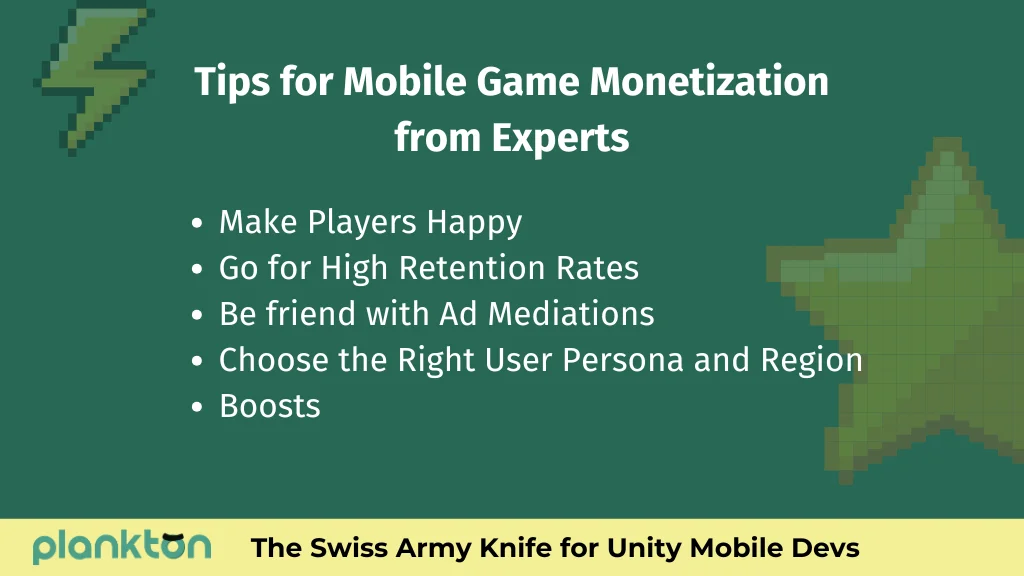
Choose the Right User Persona and Region
If you want to run a user acquisition campaign and gain new players, it’s worth it to do your homework and study your target audience. Think about who is your ideal player, what they like, what they don’t like, how old are they, etc.
Take some time to find out which game type works best in each country. Try to incorporate your users’ mother tongue into the game if possible, as it boosts user engagement.
By doing research before launching the campaign, you’ll increase your chances of attracting your ideal users and can expect more revenue.
If you have already thought about every aspect, let’s see how you can make the most of your monetization strategies.
How to Increase your Mobile Game Monetization
You know, there is always room for improvement. To boost your revenue and get the best results with your strategies, we have something called monetization optimization.
OK, what is that?
It refers to strategies that not only increase your revenue but also enhance the experience of your players. In optimization, you aim for adding more ad networks or optimizing the ad network itself.
Your income from in-game advertisement is calculated by your ad impressions multiplied by eCPM.
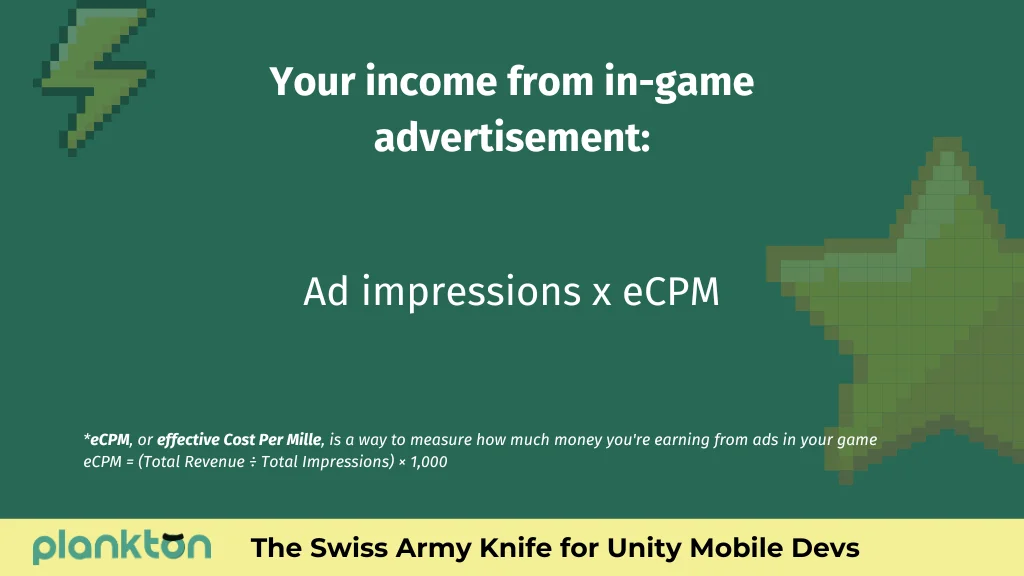
eCPM, or effective Cost Per Mille, is a way to measure how much money you’re earning from ads in your game. It shows how much you make for every 1,000 ad impressions. Think of it as your “ad revenue score”—the higher it is, the more you’re earning!
Think about your product before everything else. If you don’t create a mobile game that can’t attract people to play it, then you’re in trouble. And don’t forget about technical issues. I mean, the monetization elements of your game should run smoothly; otherwise, nobody can save you.
What are some common technical issues affecting your mobile game revenue? For example, if you don’t integrate ad spaces well, you can’t serve ads to users. That means low (or zero) income for you. Another example is that if gamers can’t make purchases in a user-friendly way, monetizing your mobile game will fail.
Conclusion
Throughout this post, I’ve covered nearly every aspect of mobile game monetization, from how to start earning money to the importance of balancing user experience with profitability.
You’ve learned about different monetization models, including in-app ads, in-app purchases, paid models, subscriptions, and the most effective one: the hybrid model. I also walked you through various ad types and in-app purchase options.
And the crème de la crème are the tips from industry experts that help you boost your revenue while maintaining the joy of a mobile game. I tried to provide examples for each section to help you better get the idea.
I think if you’re thinking about taking your game to the market, this blog post is a handy tool that equips you with the knowledge you need to make money while you don’t compromise the nature of a gaming app.
I’m not completely finished yet!
If you have doubts or need extra help, don’t hesitate to leave your game genre in the comments, and I’ll tell you which monetization strategy best fits your mobile game.

